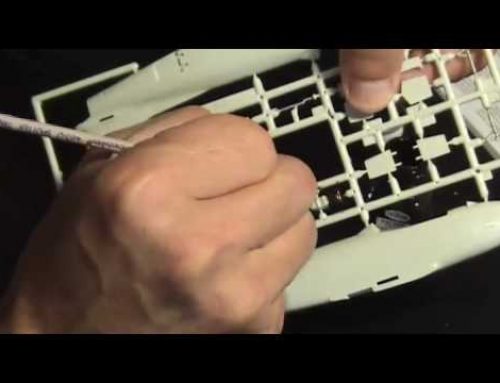More paint testing as part of the 1/144 Spaceship Model Projects.
As before, I’m using both Tamiya and E’tac paints in this test. The main focus this time was to see how Future (or its current incarnation,
The Future Adhesion Test
For the support I used a piece of sheet styrene and wiped it down to remove grease and any other surface impurities. I then used tape to mask out a strip through the middle of the sheet. One coat of Future was airbrushed on an allowed to cure for a day. I removed the tape, and the color strips were airbrushed on and allowed to cure overnight.
Future and all colors were sprayed with an Iwata
I then applied some
The only stripe without paint pulling off from the un-Futured area was the Tamiya thinned with IPA. Most of the E’tac variations had extreme pull-up except the strip that had been buffered (made opaque) with white paint…and even that had significant pull-up.
In the Futured areas, the E’tac Black and Magenta both show some thinning under strong lights but no actual pull-up. All the other strips look untouched.
The Solvent Test
 To my previous sample, I airbrushed a coat of Future. After allowing it to cure overnight, I used a cotton swap dipped in three different solvents to see their effects. The solvents used were: A) IPA; B) heptane (
To my previous sample, I airbrushed a coat of Future. After allowing it to cure overnight, I used a cotton swap dipped in three different solvents to see their effects. The solvents used were: A) IPA; B) heptane (
As you can see, I got down to bare paint (Tamiya black) with both IPA and Windex, with IPA being more likely to dissolve than to smudge. Heptane had negligible-if-any effect. Windex cut through the Future coat and started affecting the paint in five swipes. IPA took only three passes before the swab was picking up paint. After forty swipes with heptane, I declared the result to be clear. It should be noted that the IPA and Windex effects in the image are the result of additional swipes following the breaching of the Future.
Initial Conclusions
Future is an amazing addition to the acrylic arsenal. The degree of improvement for adhesion over bare plastic is very significant — so much so that I don’t think I’ll ever use acrylic paint on bare styrene again. Why take the risk when a quick coat of Future will prevent a world of problems?
That said, it’s not a perfect problem solver. While the paints I tested consistently bonded much better with Future, there were some colors that exhibited more effects, however slight, from masking. Perhaps an additional topcoat of Future will hide this. That will be left for an upcoming test.
The solvent test wasn’t very surprising. Given that Windex (implying also ammonia) and IPA are often used as thinners/cleaners for acrylics*, I expected them to easily attack the Future. Since I’ve used heptane as an adhesive residue remover on acrylic paintings in the past without harm, I was reassured that it was equally as tolerant of Future. So there is at least one degreasing agent that I don’t have to be concerned about.
There are more tests still to do.
* Immediately after spraying Future, I clean the residue from the airbrush with Windex, followed with water and maybe airbrush cleaner.



